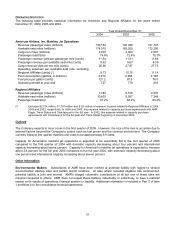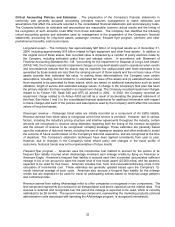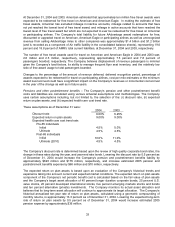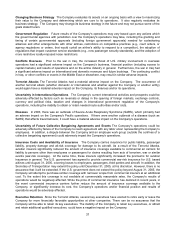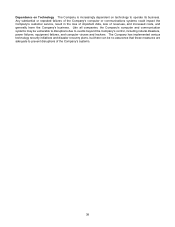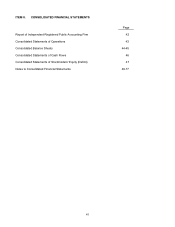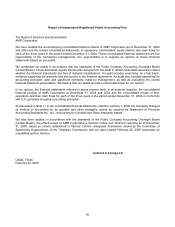American Airlines 2004 Annual Report Download - page 35
Download and view the complete annual report
Please find page 35 of the 2004 American Airlines annual report below. You can navigate through the pages in the report by either clicking on the pages listed below, or by using the keyword search tool below to find specific information within the annual report.32
Critical Accounting Policies and Estimates The preparation of the Company’s financial statements in
conformity with generally accepted accounting principles requires management to make estimates and
assumptions that affect the amounts reported in the consolidated financial statements and accompanying notes.
The Company believes its estimates and assumptions are reasonable; however, actual results and the timing of
the recognition of such amounts could differ from those estimates. The Company has identified the following
critical accounting policies and estimates used by management in the preparation of the Company’s financial
statements: accounting for long-lived assets, passenger revenue, frequent flyer program, pensions and other
postretirement benefits, and income taxes.
Long-lived assets – The Company has approximately $20 billion of long-lived assets as of December 31,
2004, including approximately $19 billion related to flight equipment and other fixed assets. In addition to
the original cost of these assets, their recorded value is impacted by a number of policy elections made by
the Company, including estimated useful lives and salvage values. In accordance with Statement of
Financial Accounting Standards No. 144, “Accounting for the Impairment or Disposal of Long-Lived Assets”
(SFAS 144), the Company records impairment charges on long-lived assets used in operations when events
and circumstances indicate that the assets may be impaired, the undiscounted cash flows estimated to be
generated by those assets are less than the carrying amount of those assets and the net book value of the
assets exceeds their estimated fair value. In making these determinations, the Company uses certain
assumptions, including, but not limited to: (i) estimated fair value of the assets and (ii) estimated future cash
flows expected to be generated by these assets, which are based on additional assumptions such as asset
utilization, length of service and estimated salvage values. A change in the Company's fleet plan has been
the primary indicator that has resulted in an impairment charge. The Company recorded impairment charges
related to its Fokker 100, Saab 340 and ATR 42 aircraft in 2002. In 2003, the Company recorded an
impairment charge related to its Airbus A300 aircraft as a result of accelerating the planned retirement of
this fleet. See Notes 1 and 2 to the consolidated financial statements for additional information with respect
to these charges and each of the policies and assumptions used by the Company which affect the recorded
values of long-lived assets.
Passenger revenue – Passenger ticket sales are initially recorded as a component of Air traffic liability.
Revenue derived from ticket sales is recognized at the time service is provided. However, due to various
factors, including the industry’s pricing structure and interline agreements throughout the industry, certain
amounts are recognized in revenue using estimates regarding both the timing of the revenue recognition
and the amount of revenue to be recognized, including breakage. These estimates are generally based
upon the evaluation of historical trends, including the use of regression analysis and other methods to model
the outcome of future events based on the Company’s historical experience, and are recognized at the time
of departure. The Company’s estimation techniques have been applied consistently from year to year.
However, due to changes in the Company’s ticket refund policy and changes in the travel profile of
customers, historical trends may not be representative of future results.
Frequent flyer program – American uses the incremental cost method to account for the portion of its
frequent flyer liability incurred when AAdvantage members earn mileage credits by flying on American or
American Eagle. American's frequent flyer liability is accrued each time a member accumulates sufficient
mileage in his or her account to claim the lowest level of free travel award (25,000 miles) and the award is
expected to be used for free travel. American includes fuel, food, and reservations/ticketing costs in the
calculation of incremental cost. These estimates are generally updated based upon the Company’s 12-
month historical average of such costs. American also accrues a frequent flyer liability for the mileage
credits that are expected to be used for travel on participating airlines based on historical usage patterns
and contractual rates.
Revenue earned from selling AAdvantage miles to other companies is recognized in two components. The
first component represents the revenue for air transportation sold and is valued at current market rates. This
revenue is deferred and recognized over the period the mileage is expected to be used, which is currently
estimated to be 28 months. The second revenue component, representing the marketing products sold and
administrative costs associated with operating the AAdvantage program, is recognized immediately.











